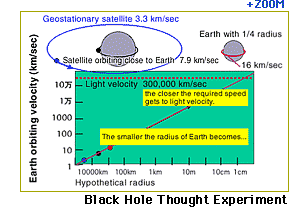What kind of phenomenon does the term "black hole" describe? Let us conduct an extremely simple thought experiment. First, picture an artificial satellite going around the Earth. Geostationary satellites, such those used for communications and meteorology, fly at an altitude of 36,000 km, at a velocity of 3.3 km/sec. To us, they seem static, since they are orbiting in sync with the 24-hour rotation of the Earth. There are some lower-flying satellites that need to orbit at a higher velocity, to keep the Earth's gravity from pulling them down. Suppose there was no air resistance. In that case, a satellite flying close to the surface of the Earth would need to maintain a velocity of around 7.9 km/sec. This is called circular astronautical velocity.  Second, picture a satellite flying close to the surface of an Earth. Let's say Earth shrinks to the point where its radius is one-quarter of what it is now. The resulting increase in gravity would force the satellite to fly at the much higher velocity of 16 km/sec in order not to crash. The chart on this page illustrates that a smaller, denser Earth would force the satellite to fly at a higher velocity in order not to be pulled down by gravity. The horizontal axis indicates the hypothetically reduced radii of Earth, with a logarithmic scale mark placed every time the radius is reduced 10 times. Second, picture a satellite flying close to the surface of an Earth. Let's say Earth shrinks to the point where its radius is one-quarter of what it is now. The resulting increase in gravity would force the satellite to fly at the much higher velocity of 16 km/sec in order not to crash. The chart on this page illustrates that a smaller, denser Earth would force the satellite to fly at a higher velocity in order not to be pulled down by gravity. The horizontal axis indicates the hypothetically reduced radii of Earth, with a logarithmic scale mark placed every time the radius is reduced 10 times.As you can see from this chart, the smaller the Earth becomes, the higher the velocity required to stay in orbit. At a certain point, the required velocity reaches the speed of light. But since matter cannot move faster than light, it would be impossible for the satellite to maintain its flight, and it would crash into the Earth. In other words, if the radius of a celestial body is reduced to a certain point, the orbital velocity required to keep anything flying close to its surface becomes higher than light velocity, making it impossible for any matter, including light, to escape being pulled into the celestial body. This is the idea of black holes that Schwarzschild discovered mathematically. To what extent, then, does a celestial body need to be reduced to become a black hole? The "limit of the radius" is proportional to the mass of a celestial body. For example, Earth would become a black hole if its radius were compressed to less than 5 mm, while the Sun would become one if its radius were reduced to less than 3 km. During the 1960s, we came to understand in general terms how a heavy star turns into a black hole. An adolescent star contains a large amount of hydrogen. Atomic fusion in the star's central core turns that hydrogen into helium. When the hydrogen in the central core is rapidly depleted, the core shrinks under the influence of its own gravity. That in turn heats up the star's outer layer, which expands as a result, and the star becomes a "red giant." Eventually, this process reaches its limit, a supernova explosion occurs, and the central core of the star collapses under the influence of its own gravity, with neutrinos discharged and the outer layer blowing off. If the mass of the original star is not too great, the collapsed central core becomes a neutron star. If it is a particularly massive star, a black hole comes into being.  A black hole is formed when the collapsed central core of the star exactly matches the limit of the radius, as explained above. The outer limit of the black hole is called the "event horizon." While light emitted outward from just outside this horizon manages to escape after being bent, any light inside the horizon goes toward the center and can never escape. A black hole is formed when the collapsed central core of the star exactly matches the limit of the radius, as explained above. The outer limit of the black hole is called the "event horizon." While light emitted outward from just outside this horizon manages to escape after being bent, any light inside the horizon goes toward the center and can never escape.In other words, the event horizon is the border that separates our world from the world on the other side. The idea of the black hole means two things: a collapsed star, and a border between these two worlds. |
||||||
|
||||||